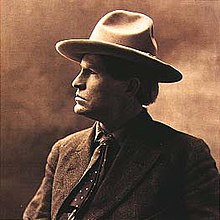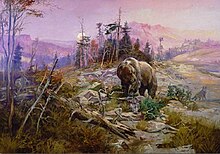Charles M. Russell
Charles Marion Russell (born March 19, 1864 in Oak Hill , St. Louis , Missouri , USA ; † October 25, 1926 in Great Falls , Montana ) was an American painter , sculptor , illustrator and writer . He was known for his portrayal of the American West. Alongside Frederic Remington , he was the most important American artist of his time. His mural titled Lewis and Clark Meet the Flathead Indians is in the State Capitol in Helena, Montana. He created a total of more than 4000 paintings and sculptures.
Life
Charles M. Russell was born in Oak Hill, a suburb of St. Louis, Missouri. His parents, Mary Elizabeth Mead and Charles Silas Russell, had four sons and a daughter. Even as a child, he showed his artistic talent - he always carried beeswax and drew a lot. He made his first attempts at molding with clay . Much of his interest in art certainly came from his mother, who was a talented artist.
Despite or perhaps because of his artistic abilities, he was not a good student. Russell hated school and often stayed away from class. When his grades deteriorated dramatically, his parents sent him to military school . But the hope of imparting discipline was dashed. Russell could not hold back against the officers either and was eventually expelled from school.
From an early age it was his desire to move to the Wild West and become a cowboy . In 1880, his parents agreed and sent him and a friend of the family to the Montana Territory . First, 16-year-old Russell got by with various odd jobs before he found a job as a cowboy in 1882. He worked there for the next 11 years. During this time Russell used every free minute to draw and paint.
Soon he was famous among the other cowboys, not for his riding or lasso skills, but rather for his detailed drawings and pictures. His depiction of the bitterly cold winter of 1886/1887 in Montana is of particular importance. The picture Waiting for a Chinook shows a starving, freezing young ox surrounded by wolves. This work is one of Russell's most famous paintings. His interest was not limited to the lives of white settlers and cowboys. Of the Native Americans , he said:
“The Red man was the true American. They have almost gone but will never be forgotten. " .
Russel wanted to capture her and her life in his pictures before everything was gone. In 1888 he spent some time in Canada , where he met with Indians every day . They taught him sign language and called him Ah-Wah-Cous ( antelope ). This expertise benefited his pictures and so it can be stated that he was the first painter to depict Indians not as savages, but rather as worthy noblemen of the prairie .
In 1896, at the age of 32, he married Nancy Cooper, who was just 18 years old. With her he moved to Great Falls (Montana) and set up a studio there. She supported him in his work, took care of the finances in a skilful manner and enabled him to concentrate fully on the art. In 1911 he was able to open his first solo exhibition The West That Has Passed in New York . This meant entering the national and international art world. He was commissioned by the House of Representatives of the US state of Montana to create a painting for the State Capitol Building . In 1914 he showed his works in London .
During a visit to Calgary , Canada , the Prince of Wales bought a picture of Russell that now hangs in Buckingham Palace . The painting changed hands for $ 10,000. At the time, it was the highest price ever paid for a painting by a living American artist. From now on Russell showed his works across the country. In 1925 a special exhibition was held in his honor at the Corcoran Gallery of Art in Washington, DC . But since 1923 Russell suffered from sciatica , which increasingly disabled him. He died of a heart attack in Great Falls, Montana , on October 25, 1926, at the age of 62 .
... as a painter
The painter Charles M. Russell is known for his depiction of the western United States. The subjects of his artistic representations are cowboys and Indians as well as the landscape and nature of the Old West. He was also particularly interested in the Lewis and Clark Expedition . In total, he created more than 4000 paintings and sculptures. Much of his work is on display at the CM Russell Museum (Great Falls, Montana). Individual images can be found in the Metropolitan Museum of Art (New York City), Minneapolis Institute of Art ( Minnesota ), National Cowboy & Western Heritage Museum ( Oklahoma ), Sid Richardson Collection of Western Art ( Texas ), Amon Carter Museum (Texas), Glenbow Museum ( Alberta , Canada ), Rockwell Museum of Western Art ( Corning, NY ), The Whitney Gallery of Western Art at the Buffalo Bill Historical Center in Cody , Wyoming and the Stark Museum of Art (Texas)
See also: works / paintings
... as a writer
Russell published three books of short stories in 1921, 1925, and 1927 . His stories, like his pictures and sculptures, are about life in the Wild West. The figure of Rawhide Rawlins repeatedly appears as the narrator in his literary work. All books were illustrated by himself.
See also: works / literature
Works
painting
- Indian Braves (New York City, Metropolitan Museum of Art, Inv. No. 1970.286), watercolor on paper, 1899, 53 cm × 74.6 cm
- Lewis and Clark Meeting the Flathead Indians (Helena, Montana State Capitol), oil on canvas, 1912, 3.65 mx 7.61 m
Books
- Rawhide Rawlins Stories , Montana Newspaper Assoc., Great Falls (1921)
- More Rawhides , Montana Newspaper Assoc., Great Falls (1925)
- Trails Plowed Under , Doubleday & Company (1927)
- Good Medicine; The Illustrated Letters of Charles M. Russell , Doubleday, Doran & Company, 1929
Museums
- CM Russell Museum , Great Falls, Montana: Preservation, collection, research and interpretation of the art of Charles M. Russell
literature
- Raphael James Cristy: Charles M. Russell. The storyteller's art . Univ. of New Mexico Press, Albuquerque 2004. ISBN 0-8263-3284-6
- Brian W. Dippie: Looking at Russell. Amon Carter Museum, Fort Worth, Tex. 1987. ISBN 0-88360-079-X
- Charlie Russell roundup. Essays on America's favorite cowboy artist , ed. v. Brian W. Dippie. Montana Historical Society Press, Helena 1999. ISBN 0-917298-47-0
- Charles M. Russell. Paintings, drawings, and sculpture in the Amon G. Carter Collection , ed. v. Frederic G. Renner. Univ. of Texas Press, Austin et al. a. 1966.
- Rick Stewart: Charles M. Russell, sculptor . Abrams, New York 1994. ISBN 0-8109-3772-7
- John Taliaferro: Charles M. Russell: The Life and Legend of America's Cowboy Artist. Little, Brown, Boston, 1996. ISBN 0-316-83190-5
Web links
- CM Russell Museum (English)
- Padgett, Andrea: Biography of Charles M. Russell (English)
| personal data | |
|---|---|
| SURNAME | Russell, Charles M. |
| ALTERNATIVE NAMES | Russell, Charles Marion |
| BRIEF DESCRIPTION | American painter, sculptor, illustrator, and writer |
| DATE OF BIRTH | March 19, 1864 |
| PLACE OF BIRTH | Oak Hill , Missouri |
| DATE OF DEATH | October 25, 1926 |
| Place of death | Great Falls , Montana |




